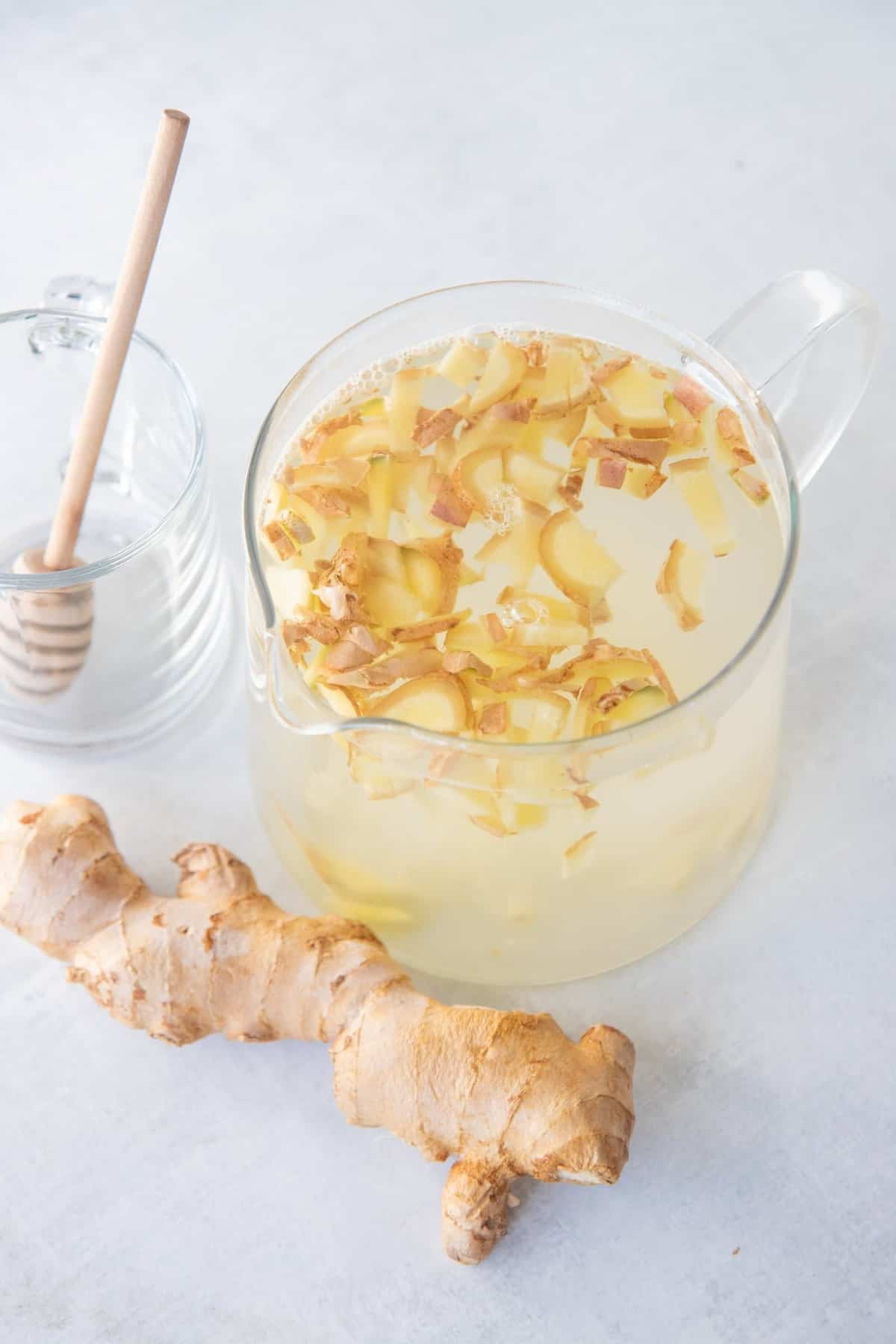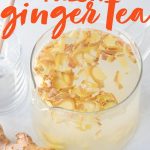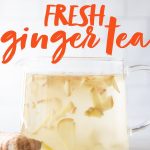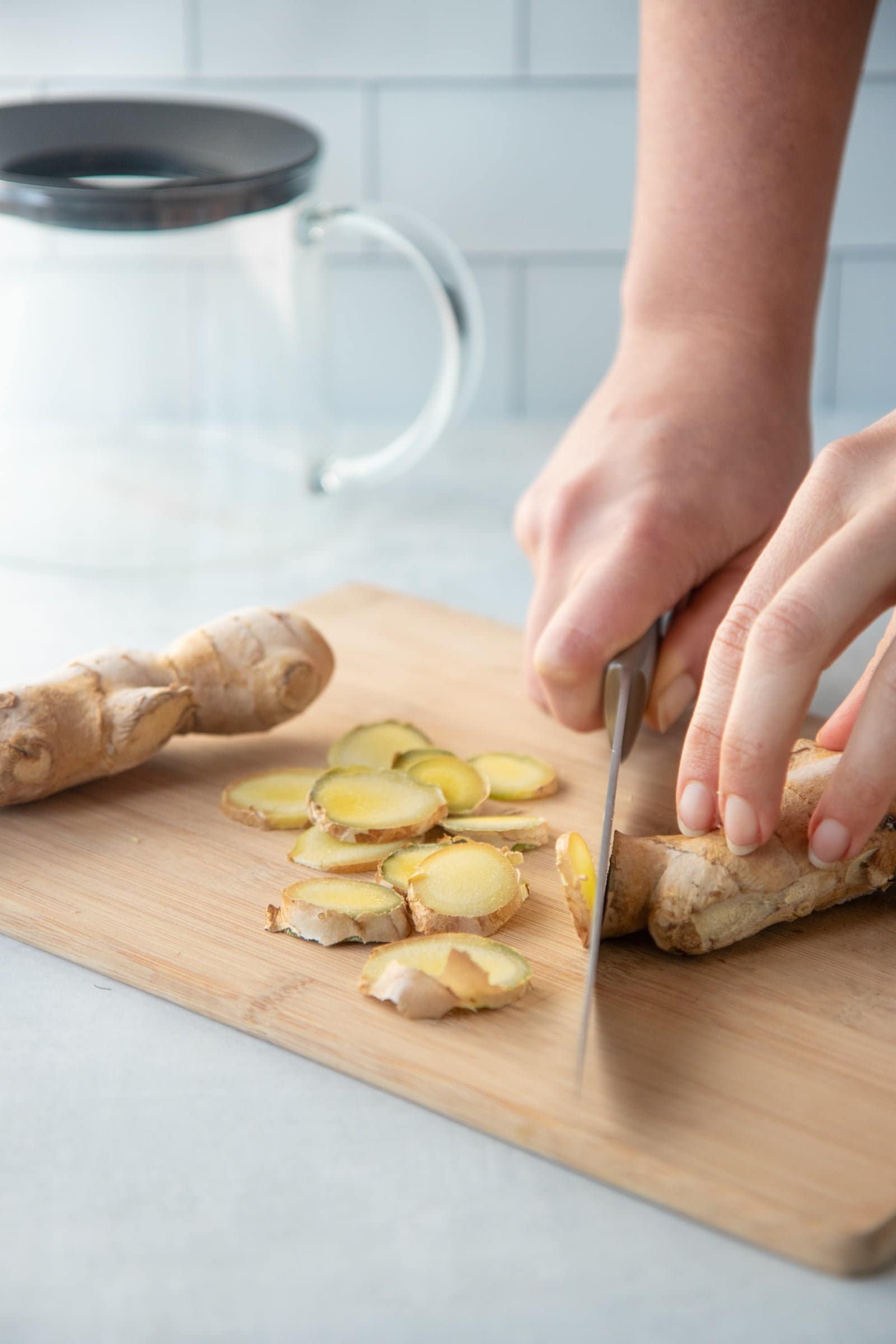A good pot of ginger tea is one of life’s simplest (and healthiest!) pleasures. Your typical mug of ginger tea ritual might start by dropping a baggie of tea into a mug of hot water, but we want to help you take your ginger tea to the next level! We’re going to show you how to make ginger tea from scratch—using fresh, frozen, or dried ginger to get the most flavor and the most health benefits.
You probably already know that ginger is one of the best all-around medicinal herbs you can add to your diet. It also has the added benefits of being super tasty, easy to find, and simple to make. If you don’t have ginger in your life, you need to add it now! Let us show you how.
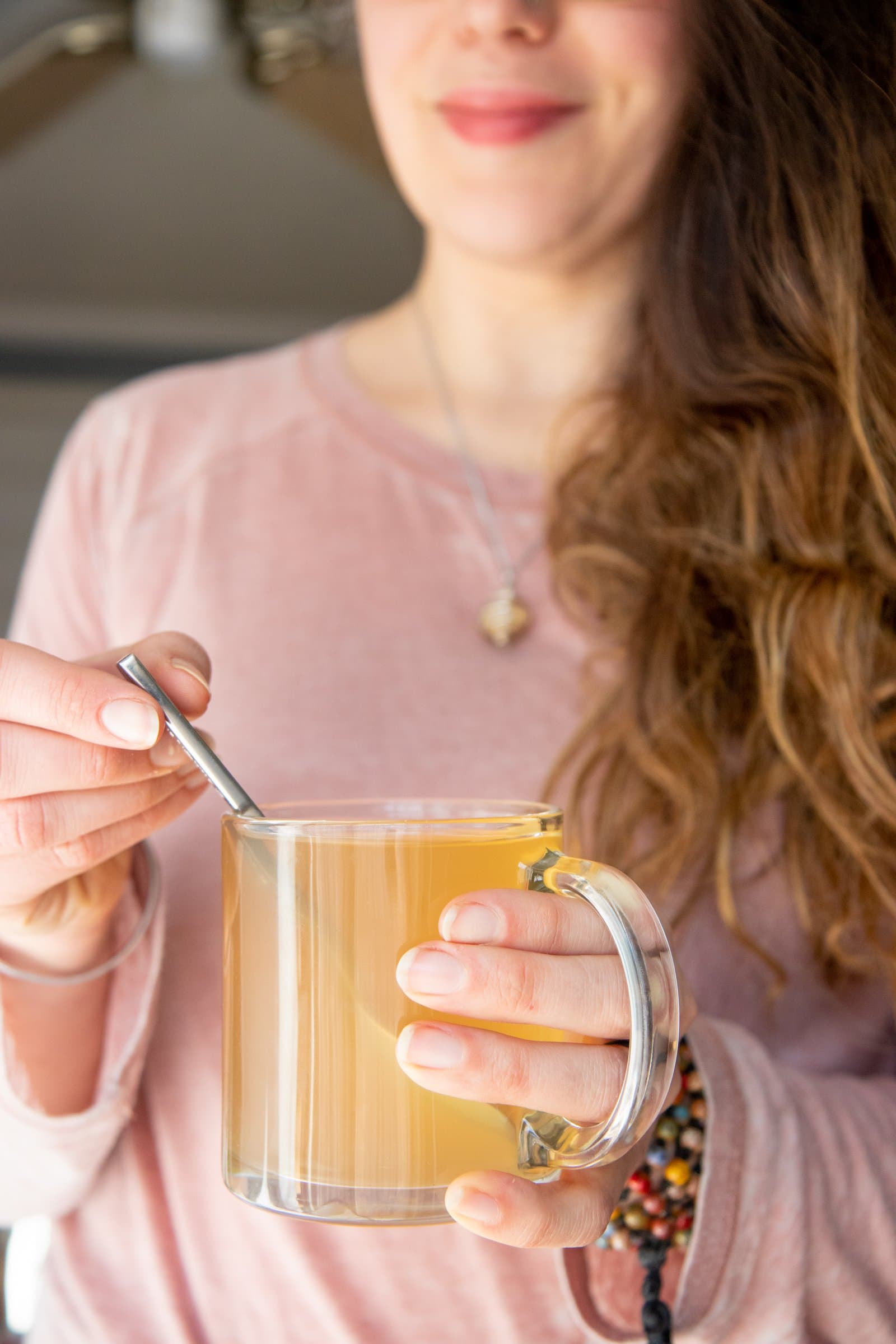
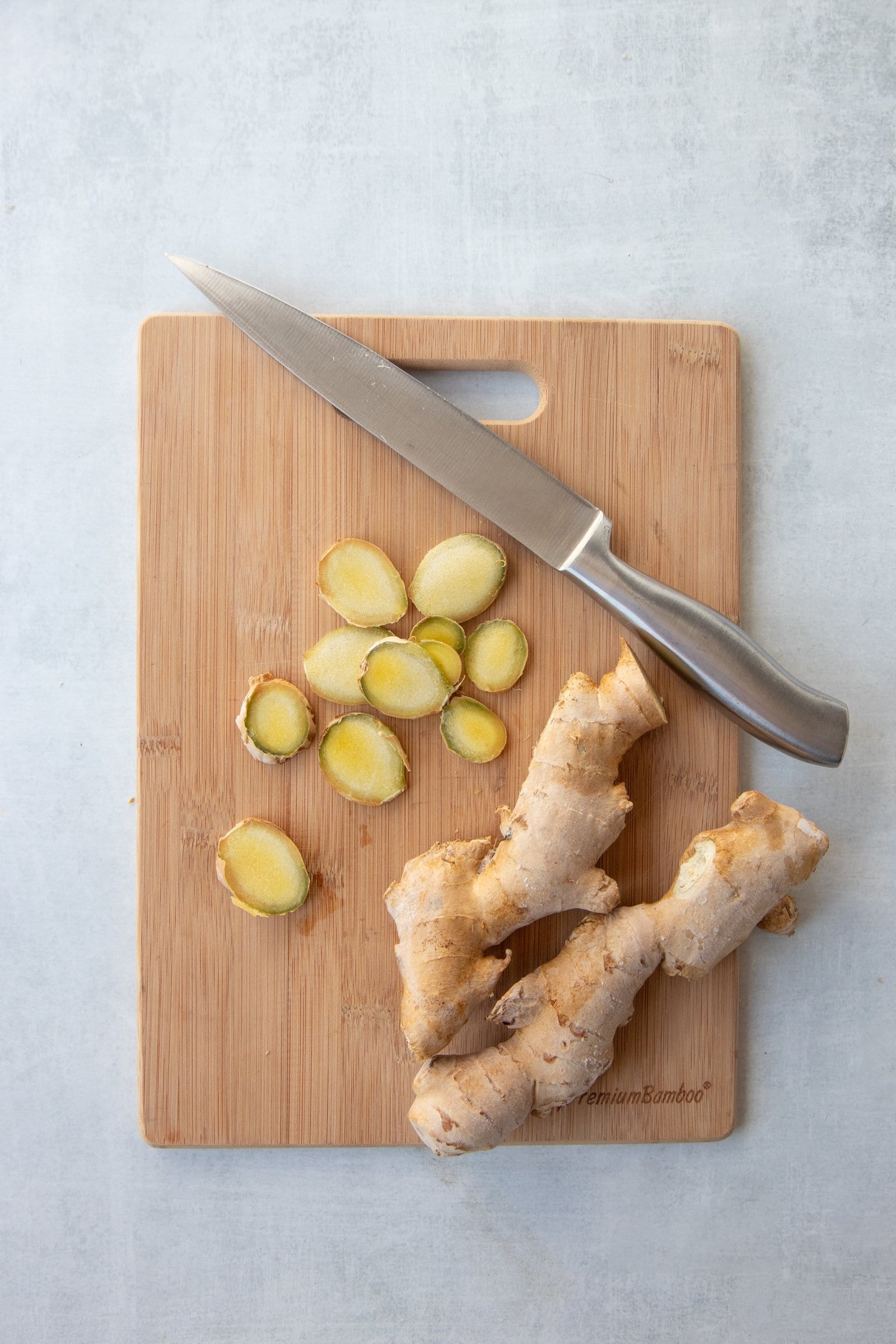
What are the health benefits of ginger tea?
Ginger has been in the arsenal of medicinal practitioners for millennia, but for those of you who want the black-and-white proof, science has also proven what folk medicine already knew—ginger has powerful anti-inflammatory properties, and is also a strong immunity-booster, anti-microbial, and tummy tamer.
Here’s just a few reasons you might want to make fresh ginger tea a regular part of your routine:
- Ginger is known as a common way to soothe upset stomach, like symptoms from motion sickness or pregnancy like indigestion or nausea. Many people recommend enjoying ginger regularly to help with digestion.
- It may help improve circulation.
- It can serve as an anti-inflammatory, thanks to the proteolytic enzymes in ginger. Ginger may help ease inflammation that contributes to headaches, sore throats, and coughs.
- Ginger can have a stimulating effect similar to that of caffeine…but it’s decaf!
- Ginger tea may help with menstrual cramps.
- It’s delicious!
As a bonus, it is easy to find, simple to prepare, and affordable.
Is it safe to drink ginger tea every day?
For most people, it is considered safe to drink ginger tea every day. But if you will be consuming a large amount daily, it is worth checking in with your healthcare professional (especially if you are on any medications) to double-check.
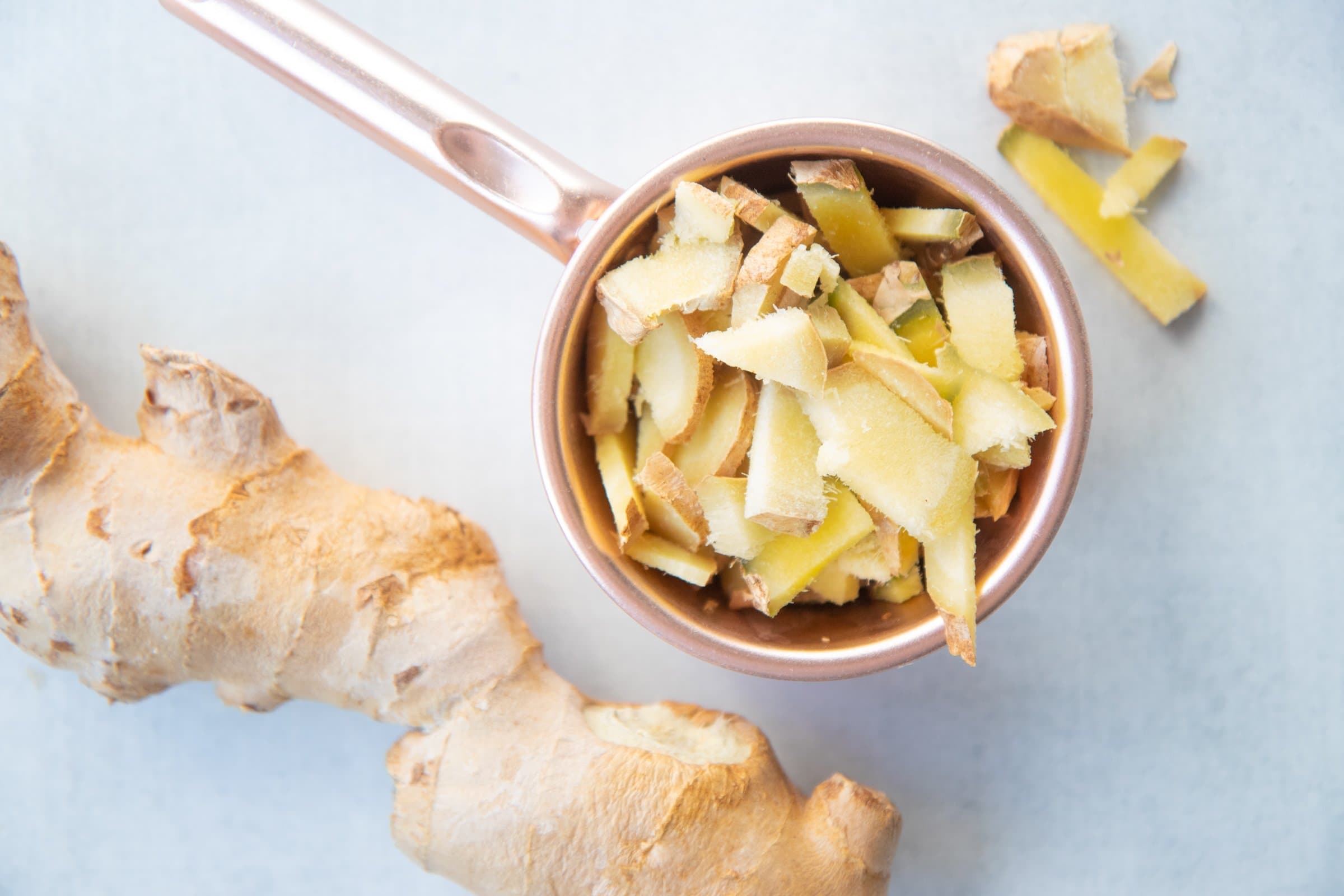
Okay, let’s talk ginger tea made with FRESH ginger.
My favorite method for making ginger tea—and the one we’re going to talk about today—is brewing from fresh or frozen ginger root. I buy my fresh ginger root from the produce section of my regular grocery store. I’d love to grow my own, but alas, unless Southern Indiana suddenly becomes tropical (or I get a greenhouse), that isn’t going to happen!
I buy my ginger root in bulk, and then freeze it. I just put the whole root in a large glass food storage container, and take it out as needed. There is no real need to truly defrost the ginger root—just put it out on the counter for about five minutes, and then you’ll be able to easily slice through it with a sharp knife.
Should I make a single cup at a time or a full pot of ginger tea?
I’m going to teach you how to make a full pot of fresh ginger tea. In theory, you could scale this down to just a single cup, but I’m going to encourage you to make a full pot at a time. Why? Well, to get a healing pot of medicinal tea, you’ll need to steep for quite a long while (I actually do overnight frequently), so it just doesn’t make logistical sense to do it one single cup at a time. Plus, for medicinal benefits, you want to drink quite a bit in a day anyway. If you just like the taste and comfort of a cup of ginger tea, go ahead and go with the tea bag or tea ball method and make your single cup.

Teach me how to make fresh ginger tea!
Step 1: Boil Your Water.
First up, set your water to boil. I do about a quart and a half of water in my tea pot each time. I recommend filtered water, and I recommend bringing it to a full rolling boil. We use (and absolutely love) this electric kettle. It is parked right next to our Berkey water filter in our kitchen for easy tea making.
Step 2: Prepare the Ginger.
While the water is boiling, slice the ginger. For every quart of water, I use about 1/2 cup of roughly chopped ginger—so closer to 3/4 cup of ginger for my full tea pot. This is a lot of ginger and makes for a very strong and spicy tea—you could obviously use more or less to taste, but I love me some strong ginger tea!
I don’t peel my ginger, but you can, if you’d like. Instead, I just slice it off the root thinly, then chop it roughly. You could also use grated ginger if you prefer, but I find that’s a lot of extra work when a rough chop works just fine!
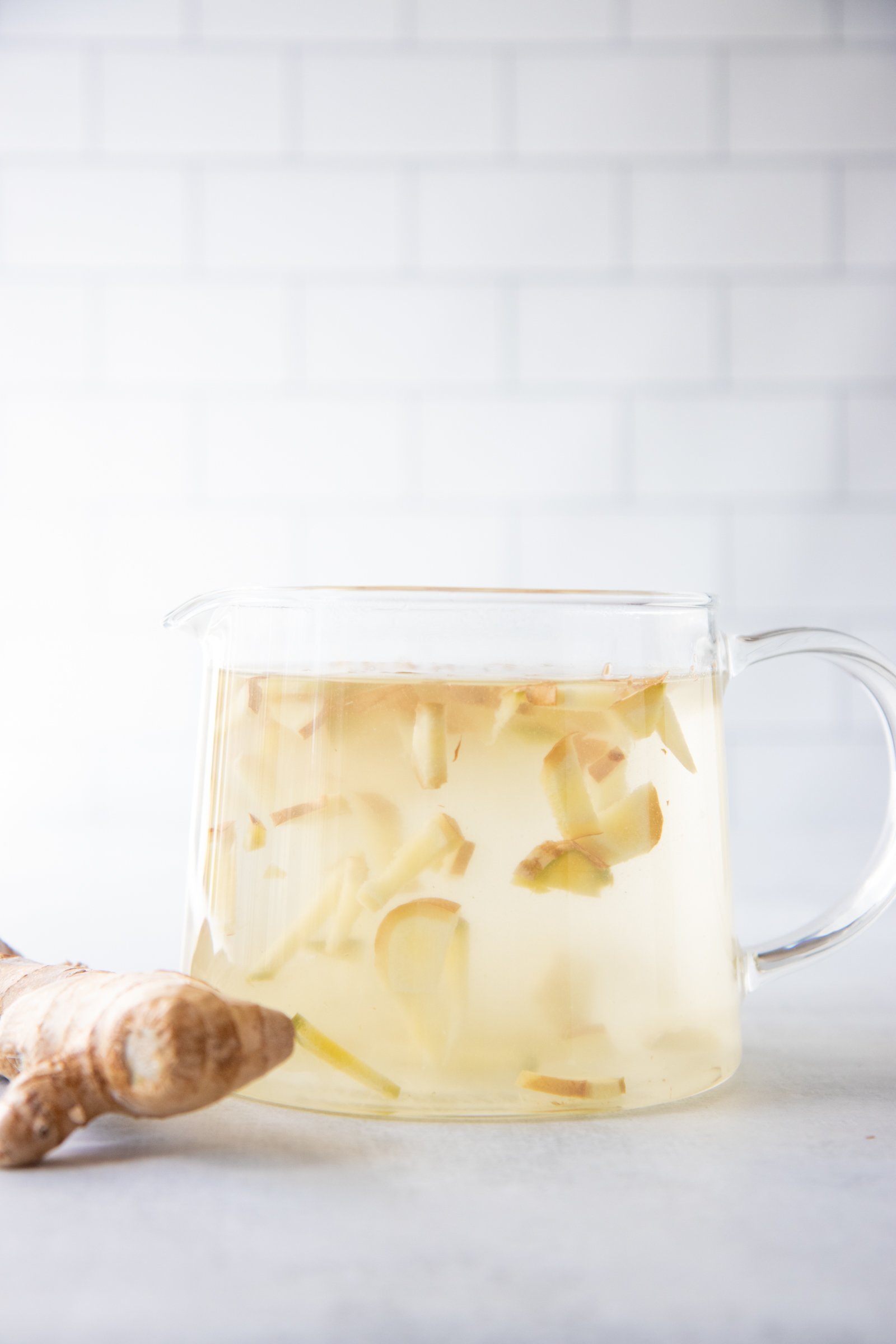
Step 3: Start Steeping.
Fill the tea pot with the ginger, and pour the boiling water over. In these pictures, I’m using the RIKLIG teapot (the big size) from IKEA. It comes with an infuser in it, which I use sometimes, but more often than not, I let my ginger free steep, and then strain when it’s time to drink.
Wholefully Protip
Because ginger is a rhizome, some folks prefer to gently simmer the ginger in water on the stovetop for a while instead of just steeping it. Around 20-30 minutes typically does the trick. Either method works!
I love this tea pot, but honestly, I don’t use it for ginger tea very often (I just needed something see-through so I could show you my steps here). I usually use this large, insulated stainless steel French press for my ginger tea every day.
Why? Well, because once the tea is steeping, I let it steep for at least an hour. And the insulated stainless steel helps keep the tea warm a lot longer than the glass.
This whole “keeping tea warm” thing is usually moot though, because I prefer to actually let it steep overnight, and then just reheat in the morning. Since ginger is a tough root, it can really benefit from a long steep time to get all those beneficial compounds out into the tea. Plus, it tastes better! I’ve just gotten in the habit of making my pot of ginger tea right before bed each night.
Step 4: Reheat (If Needed) and Enjoy!
And that’s it! If the tea is still warm, I then stir in some local raw honey to taste, strain (either using the plunger on the French press or a tea strainer), and enjoy!
If I need to reheat the tea, I just strain it into a saucepan on the stove and reheat on low heat until it is just warm enough to dissolve the honey. High heat kills a lot of the beneficial compounds in raw honey, so you don’t really want to be mixing it with tea that’s above about 110°F.
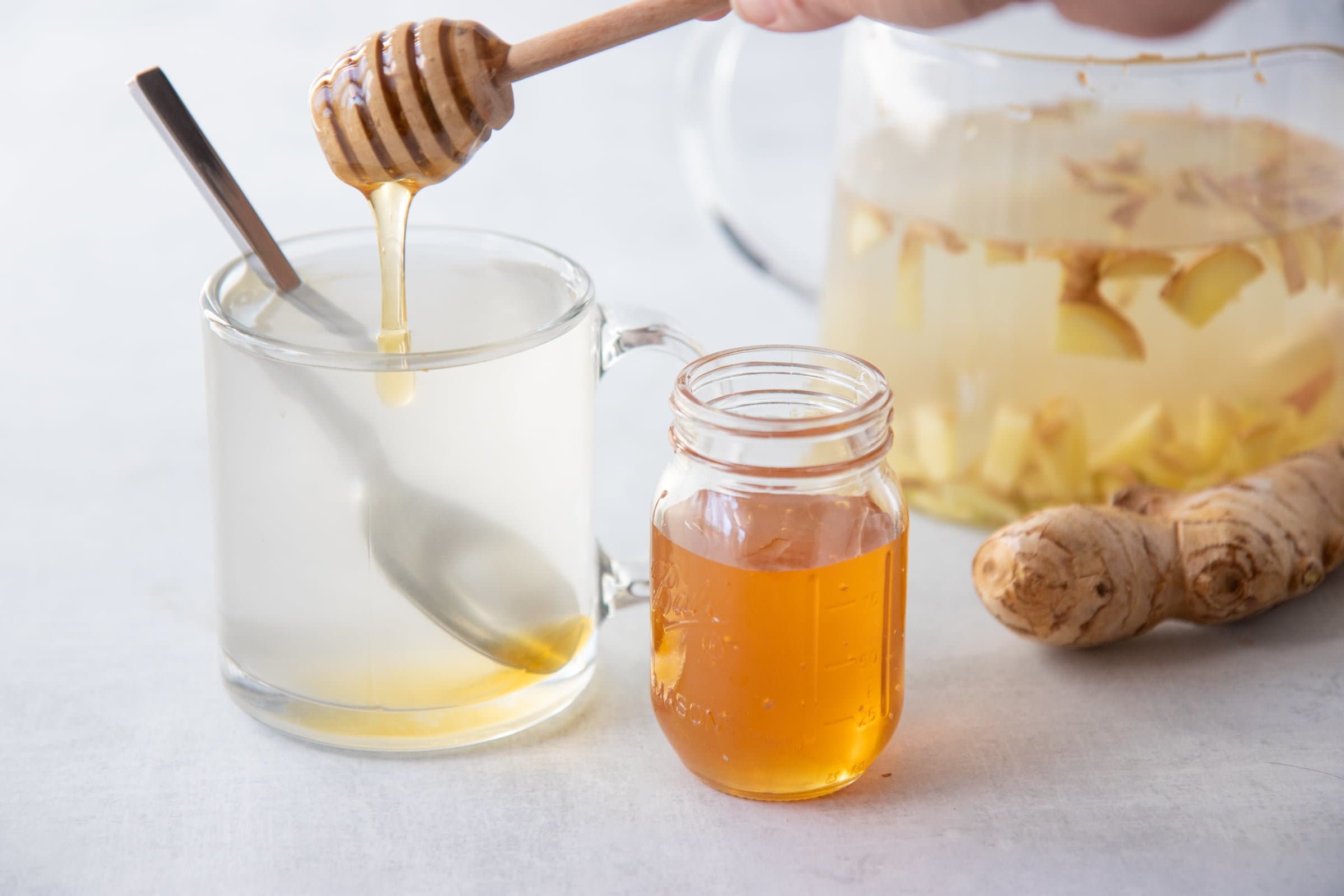
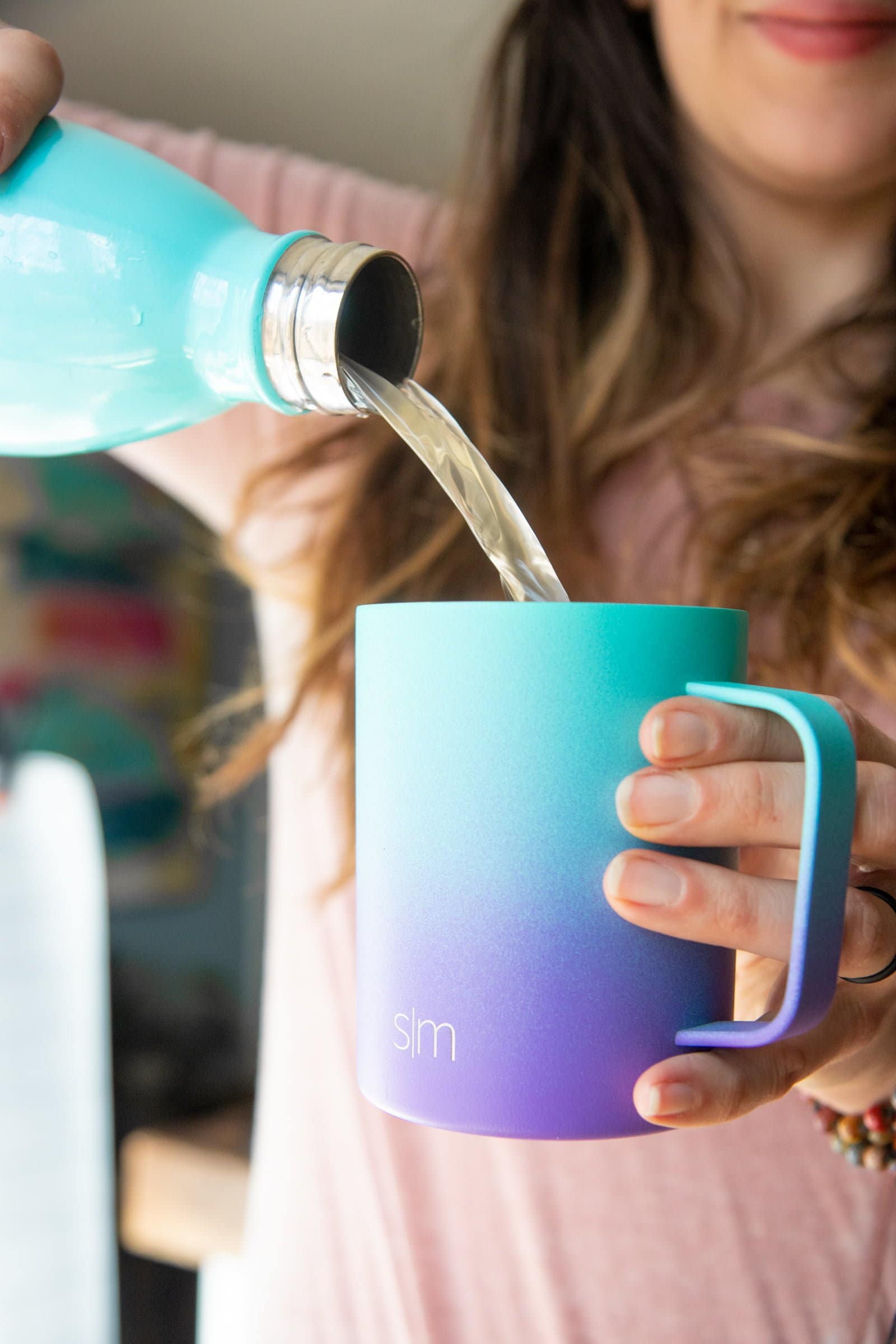
How do I keep my tea warm?
I tend to take my tea with me on the go by pouring it into this insulated stainless steel bottle. These bottles keep my tea SUPER HOT! I also have a (matching!) insulated travel mug that I pour my tea into for sipping in the car or at my office.
What should I add to my ginger tea?
I think ginger tea is perfect with just a touch of raw honey, but if you want to mix it up, you could try:
- Adding lemon juice for a fruitier tea.
- Making a ginger chai by upping the ginger in our chai recipe.
- Adding a cinnamon stick or two to your brew, for an added boost of medicinal benefits and wonderful taste.
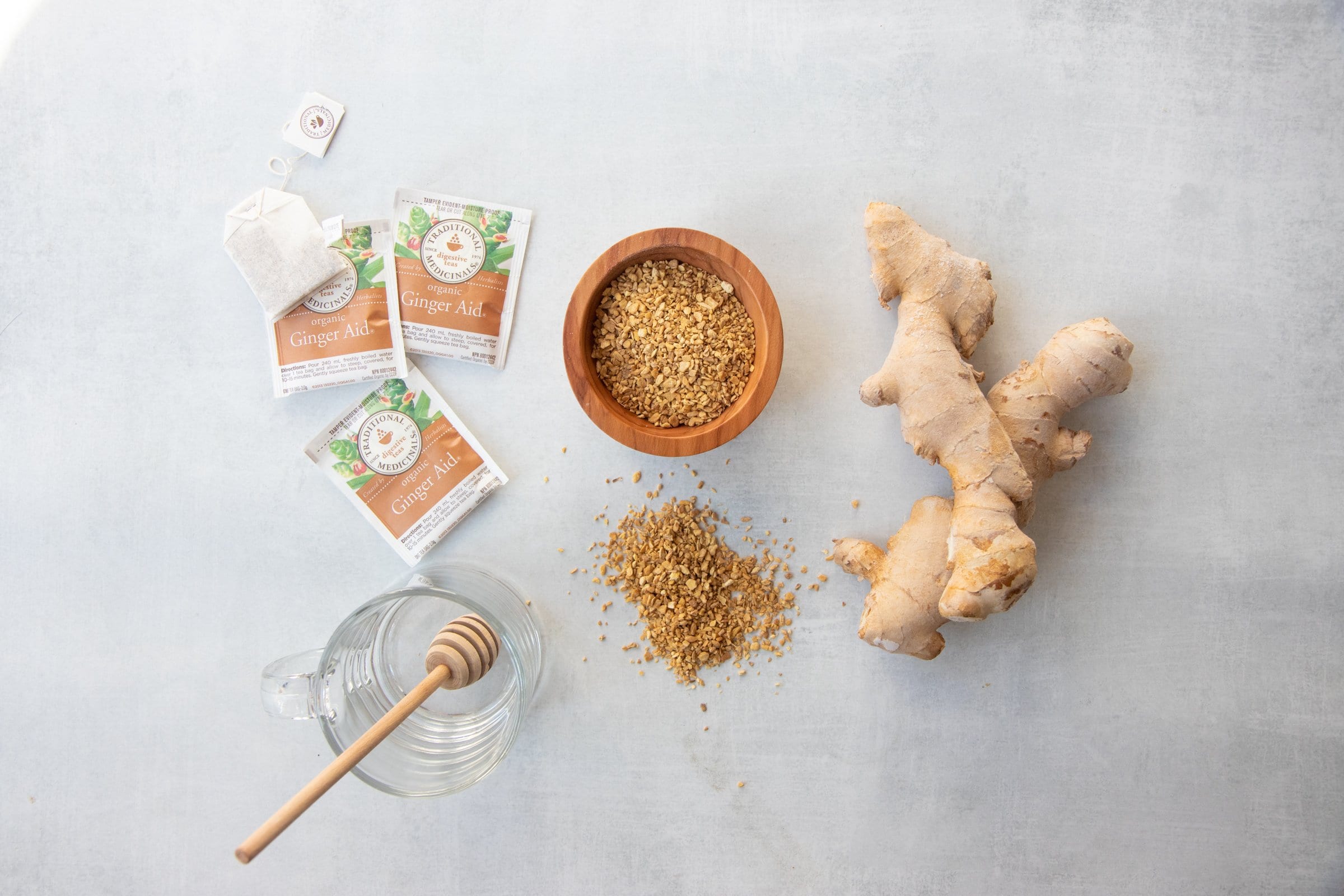
Can’t I just make ginger tea with a tea bag?
Most of you are probably used to making tea from a tea bag. It’s convenient, it’s easy, and it’s accessible. When I’m traveling, I always throw a few bags of ginger tea in my carry-on for quick brewing (pro-tip, you can always ask for a cup of hot water on an airplane and brew your own tea).
That being said, brewing ginger tea from a bag won’t give you the most medicinal bang for your buck. First of all, the actual amount of the herb in each bag is tiny (tiny!). You also have no idea how old the ginger is or what elements it has been exposed to (both of which can affect the effectiveness). Also, in general, brewing medicinal herbs in a tea bag can really limit the amount of beneficial compounds that get released. Most herbalists agree that letting herbs “free steep” is the best way to extract the most medicinal qualities. I like to think of it as giving my herbs the biggest dance floor I can!
What about using dried ginger root?
The next level up would be to purchase bulk dried ginger root and brew using a tea pot or tea ball. Just like with the tea bags, a tea ball will limit the ginger’s “dance floor,” but there are some nice large ones out there that make it so much better than the bag.
The benefit of using dried ginger is that you can control the quality and storage (I recommend keeping it in a cool, dark space), you can control how much you brew at one time, and, maybe the best of all, it is non-perishable. That being said, it’s almost a universal rule that a dried herb isn’t as potent as a fresh herb—so keep that in mind!
If you want to go this route, I recommend purchasing organic cut and sifted (often shortened to “C/S”) ginger root. I really like this one from Starwest Botanicals.
Can you freeze ginger?
Sure can! In fact, I tend to stock up on fresh ginger root to freeze every few months. I just stick the whole thing in a glass jar or glass freezer container in the freezer. Just let it sit on the counter for about five minutes before slicing.

How much ginger do you need?
For every quart of water, I use about 1/2 cup of roughly chopped ginger. That is usually around a 2 to 3-inch knob from a ginger rhizome.
How long do you steep fresh ginger tea?
To get plenty of flavor and medicinal benefits, I recommend letting your fresh ginger float around for at least an hour. But if you’re on top of your game, you can let it steep all night for a deliciously healthy tea with plenty of spice.
How do I reheat ginger tea?
You may be tempted to use the microwave, but don’t! Microwaves can overheat the tea very easily. Too hot, and you’ll kill the beneficial microbes in the raw honey—which means you’ll lose a lot of the benefits. Instead, warm it in a small saucepan on low heat just enough to dissolve the honey.
So there you have it! Now you know the not-so-complicated formula for my perfect pot of ginger tea. Enjoy!
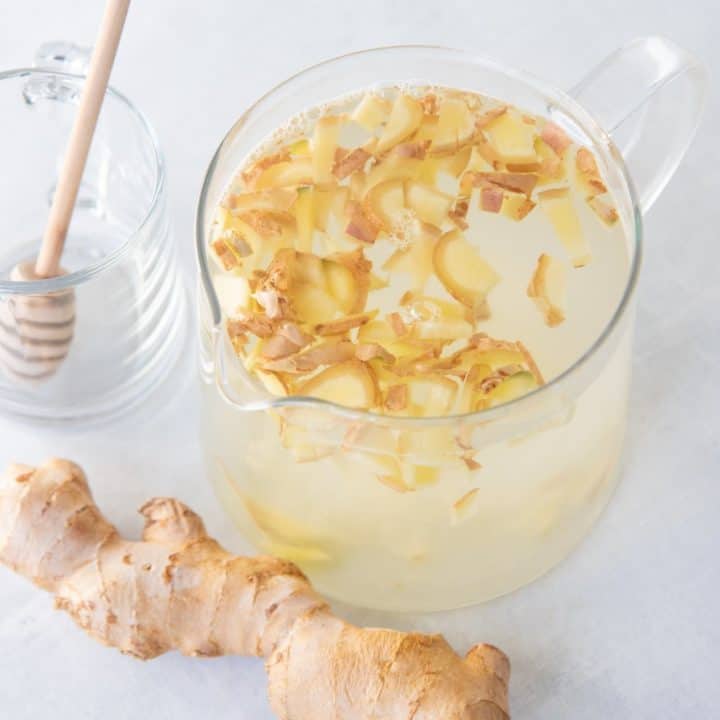
Fresh Ginger Tea Recipe
A good pot of ginger tea is one of life’s simplest (and healthiest!) pleasures. Here’s how to make the perfect pot from fresh or frozen ginger root—it works every time.
Ingredients
- 1/2 cup fresh ginger, unpeeled, roughly chopped
- 1 quart boiling water
- Honey, to taste
Instructions
- Fill a teapot with the ginger. Pour the boiling water over the ginger. Cover and let steep for at least an hour, but up to overnight.
- Strain, sweeten to taste with honey, and enjoy.
Notes
- If you need to reheat the tea, just strain it into a saucepan on the stove and reheat on low heat until it is just warm enough to dissolve the honey. High heat kills a lot of the beneficial compounds in raw honey, so you don’t really want to be mixing it with tea that’s above about 110°F.
Nutrition Information:
Yield: 4 Serving Size: 8 fl. oz.Amount Per Serving: Calories: 26Total Fat: 0gSaturated Fat: 0gTrans Fat: 0gUnsaturated Fat: 0gCholesterol: 0mgSodium: 11mgCarbohydrates: 6gFiber: 0gSugar: 5gProtein: 0g
At Wholefully, we believe that good nutrition is about much more than just the numbers on the nutrition facts panel. Please use the above information as only a small part of what helps you decide what foods are nourishing for you.
Want more home remedies like this one?
- Hot and Cold Sore Muscle Rub. This DIY muscle rub will soothe all your post-workout aches.
- Lavender Honey Burn Balm. Honey is one of the best home remedies for burns, and it features heavily in this balm.
- DIY Hand Sanitizer. While there is no real substitute for good old water and soap hand washing, this homemade sanitizer can help you out in a pinch when you don’t have a sink nearby.
- Healing Calendula Lotion. Lots of hand washing or cold winter air can do a number on your skin. This DIY lotion will keep your skin moisturized and soothed.
- Home Remedies. For more than 20 other home remedies, check out our page rounding them all up in one spot.
- Golden Milk Mix. Our golden milk mix makes deliciously cozy lattes. Keep this for yourself, or give a jar as a gift.
And check out these reader favorites!
- Chai Tea. Give the gift of a cup of tea (to yourself or others) with our homemade chai mix.
- Limoncello. This lemon liqueur is sweet, citrusy, and boozy. We’ll show you how to make it in 3 simple steps.
- Hot Sauce. Need a fun (and delicious) kitchen project? Try making your own hot sauce!
- Hot Buttered Rum. This cocktail is a holiday classic for a reason—it is sweet, creamy, and warming.
- How to Cook Spaghetti Squash. No more mushy spaghetti squash noodles for you! We’ll teach you how to avoid the three big mistakes most people make with this squash.
- Strawberry Wine. It is shockingly easy to make your own wine! We use strawberries here, but you can use this method on nearly any fruit.

